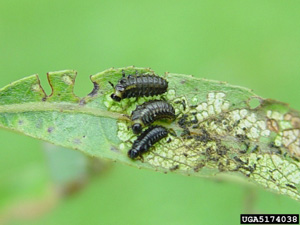DACF Home → Bureaus & Programs → Maine Forest Service → Forest Health & Monitoring → Forest Pest Index → Willow Flea Weevil and Imported Willow Leaf Beetle
WILLOW FLEA WEEVIL AND IMPORTED WILLOW
LEAF BEETLE
Rhynchaenus rufipes (Lec.)
and Plagiodera versicolora (Laich.)
Symptoms and Damage
Willow (and poplar) leaves may be severely browned by these small insects from mid-summer on. Leaves may retain their normal shape and remain on the trees but often browned leaves drop abundantly in late August and September. Depending on severity of attack, the normal green color of leaves attains a bronze or brownish cast starting in July and becoming increasingly apparent through August.
Willow Flea Weevil
Rhynchaenus rufipes (LeConte)
Description and Life Cycle
Adults are tiny, elliptical, black weevils (0.1 inch long) with orange legs that eat out tiny circular holes in the foliage, usually from the underside, and leave only the opposite leaf-surface over the hole. Adults first appear in mid-May as new leaves are developing. Holes continue to be made into July.
Eggs are laid in leaf punctures by late June. Larvae (grubs) soon hatch and feed as leaf miners within the leaf tissue, making blotch mines in the upper tissues of each leaf. Surfaces over the mines become dark brown and blister-like and are very conspicuous. Mines are completed by mid to late August at which time adults are again abundant and feeding. With cool weather adults hibernate for the winter in soil, sod, and under loose bark of trees.
Imported Willow Leaf Beetle
Plagiodera versicolora (Laicharting)

Photo: Paul Weston, Cornell University, Bugwood.org
Description and Life Cycle
Adults are oval, stout, metallic, greenish-blue beetles (1/6 inch long) and make noticeable holes through the leaves. They first appear in mid-May and are present off and on throughout the summer.
Eggs are laid in small masses on the leaves in early June. Larvae (grubs) soon hatch, feed together in rows, and remove only the leaf surface to leave a skeleton of leaf veins. Skeletonized leaves become brown. Larvae are jet black; tiny at first but when full grown are 1/4 inch long. More than one generation occurs. Winter hibernation is in the same places as for the weevils.
Control*
Bifenthrin, chlorpyrifos or pyrethrin are registered for control of the willow flea weevil and imported willow leaf beetle. The insecticide should be applied according to instructions for shade tree pests, during early June (1-11) immediately after the leaves have flattened out. A second spray application may be required in early July (1-4) to protect new growth from living adults that have moved in from surrounding unsprayed trees.
*NOTE: These recommendations are not a substitute for pesticide labeling. Read the label before applying any pesticide. Pesticide recommendations are contingent on continued EPA and Maine Board of Pesticides Control registration and are subject to change.
Caution : For your own protection and that of the environment, apply the pesticide only in strict accordance with label directions and precautions.
MAINE DEPARTMENT OF AGRICULTURE, CONSERVATION AND FORESTRY
Maine Forest Service - Forest Health and Monitoring Division
April 2000